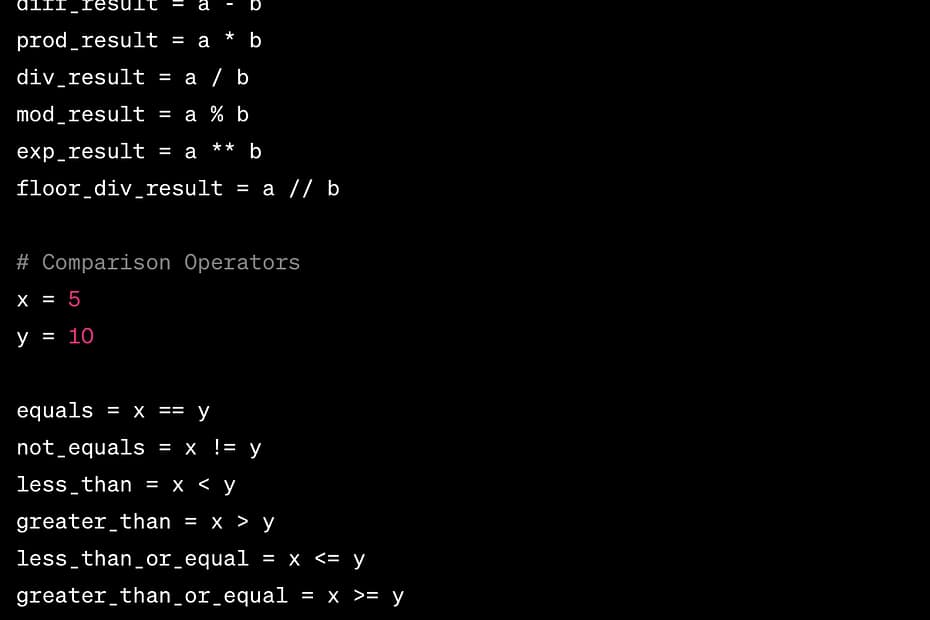Python is a versatile and widely-used programming language known for its simplicity and readability. One of the fundamental building blocks of Python, and indeed most programming languages, is operators. Operators are symbols that perform operations on variables and values. They enable us to manipulate data and control the flow of our programs. In this blog post, we will explore Python operators, their types, and how to use them effectively.
Types of Python Operators
Python operators can be categorized into several types based on their functionality:
1. Arithmetic Operators
Arithmetic operators perform basic mathematical operations like addition, subtraction, multiplication, and division. They are essential for numeric calculations in Python. Here are some common arithmetic operators:
+(Addition)-(Subtraction)*(Multiplication)/(Division)%(Modulus – remainder of division)**(Exponentiation)//(Floor Division – division that rounds down to the nearest integer)
a = 10
b = 3
sum_result = a + b # 13
diff_result = a - b # 7
prod_result = a * b # 30
div_result = a / b # 3.3333333333333335
mod_result = a % b # 1
exp_result = a ** b # 1000
floor_div_result = a // b # 3
2. Comparison Operators
Comparison operators are used to compare two values or expressions. They return a Boolean value (True or False) based on whether the comparison is true or false. Common comparison operators include:
==(Equal to)!=(Not equal to)<(Less than)>(Greater than)<=(Less than or equal to)>=(Greater than or equal to)
x = 5
y = 10
equals = x == y # False
not_equals = x != y # True
less_than = x < y # True
greater_than = x > y # False
less_than_or_equal = x <= y # True
greater_than_or_equal = x >= y # False
3. Logical Operators
Logical operators are used to combine conditional statements. They are often used in control structures like if statements and loops. Python has three primary logical operators:
and(Logical AND)or(Logical OR)not(Logical NOT)
a = True
b = False
and_result = a and b # False
or_result = a or b # True
not_result = not a # False
4. Assignment Operators
Assignment operators are used to assign values to variables. They include the standard assignment operator (=) as well as shorthand operators that perform an operation while assigning a value. Common assignment operators include:
=(Assignment)+=(Addition and assignment)-=(Subtraction and assignment)*=(Multiplication and assignment)/=(Division and assignment)%=(Modulus and assignment)**=(Exponentiation and assignment)//=(Floor division and assignment)
x = 5
x += 3 # x is now 8
y = 10
y -= 2 # y is now 8
5. Bitwise Operators
Bitwise operators manipulate the individual bits of integers. They are often used in low-level programming and for optimizing code. Python supports the following bitwise operators:
&(Bitwise AND)|(Bitwise OR)^(Bitwise XOR)~(Bitwise NOT)<<(Left shift)>>(Right shift)
a = 5 # Binary: 101
b = 3 # Binary: 011
bitwise_and = a & b # 1 (Binary: 001)
bitwise_or = a | b # 7 (Binary: 111)
bitwise_xor = a ^ b # 6 (Binary: 110)
bitwise_not = ~a # -6 (Binary: 11111111111111111111111111111010)
6. Membership Operators
Membership operators are used to test whether a value is present in a sequence like a list, tuple, or string. Python provides two membership operators:
in(True if value is found in the sequence)not in(True if value is not found in the sequence)
my_list = [1, 2, 3, 4, 5]
is_present = 3 in my_list # True
is_not_present = 6 not in my_list # True
7. Identity Operators
Identity operators are used to compare the memory location of two objects. Python has two identity operators:
is(True if both objects are the same)is not(True if both objects are not the same)
x = [1, 2, 3]
y = x
same_object = x is y # True
not_same_object = x is not [1, 2, 3] # True
Conclusion
Python operators are indispensable tools in a programmer’s toolbox. They allow us to perform a wide range of operations, from basic arithmetic calculations to complex logical decisions. Understanding the types of operators and how to use them effectively is crucial for writing efficient and expressive Python code. So, whether you’re a beginner or an experienced Python developer, mastering an operator is a fundamental step in your journey to becoming a proficient Python programmer.
